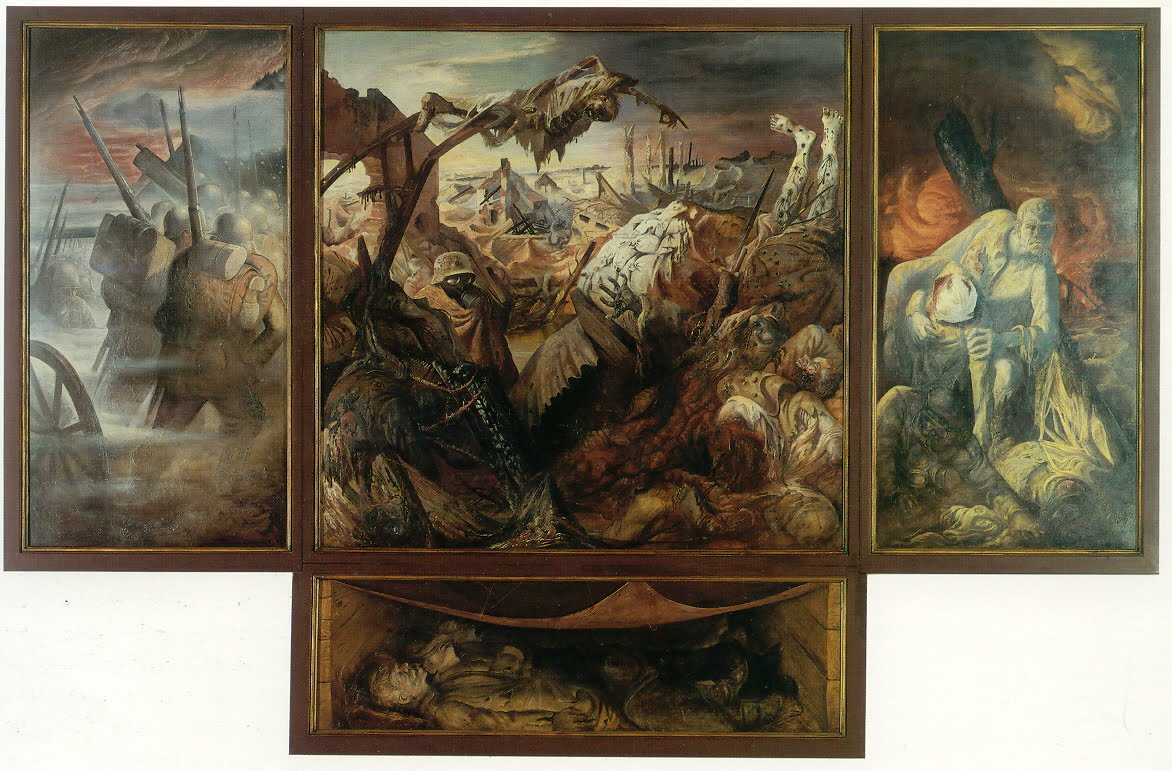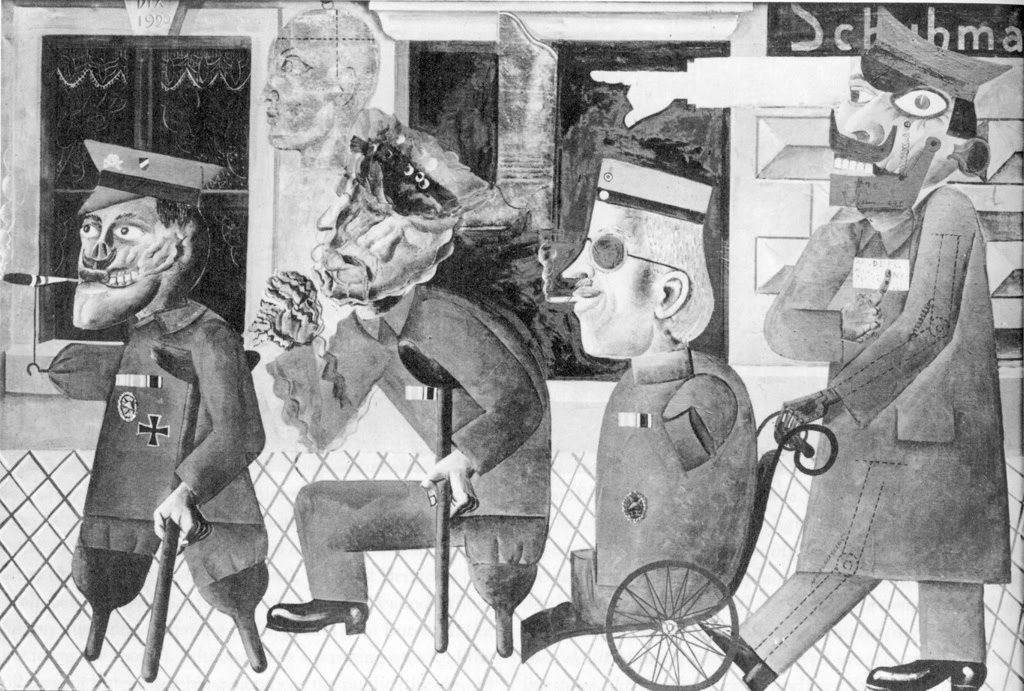 Otto Dix
Otto Dix
Otto Dix was born in Untermhaus, Germany 1891. In 1910 he became a student at the Dresden School of Arts and Crafts, and did commissioned portrait paintings to help him through school. Dix volunteered in to join the army when The Great war broke out in 1914. In 1915 Dix was assigned to he Western Front and he served as a non-commissioned office in the Machine gun unit. He was a part of the battle of the Somme during the allied offensive in 1916. In 1917 he fought on the eastern front. By the end of the war in 1918 Dix had been injured several times, one almost fatal when shrapnel hit him in the neck. Dix was awarded the Iron Cross (second class) and had reached the rank of Vice-Sergeant Major. Of his time in the German army Dix stated:
"I had to experience how someone beside me suddenly falls over and is dead and the bullet has hit him squarely. I had to experience that quite directly. I wanted it. I’m therefore not a pacifist at all – or am I? Perhaps I was an inquisitive person. I had to see all that myself. I’m such a realist, you know, that I have to see everything with my own eyes in order to confirm that it’s like that. I have to experience all the ghastly, bottomless depths of life for myself…" - Otto Dix Interview with Maria Wetzel (1963)[1]
In 1924 a body of work named Der Krieg (War) came about as a direct result of Dix experiences during the war. Der Krieg was a cycle of prints (51 in total) and was modelled on Goya’s cycle of 82 etchings from his experiences during the napoleonic war"Los Desastres de la Guerra" [The disasters of war].






"Dix manipulated the etching and aquatint mediums to heighten the emotional and realistic effects of his meticulously rendered images of horror. He stopped out ghastly white bones and strips of no man's land, leaving brilliant white patches; multiple acid baths ate away at the images, mimicking decaying flesh." - Heather Hess, German Expressionist Digital Archive Project, German Expressionism: Works from the Collection. 2011.
Belonging to an movement of artists who emerged at the end of the Great War called 'Neue Sachlichkeit' or New Objectivity, Dix along with Georg Grosz became one of the fundamental figures in the Verist camp of painters. Dix's paintings were hugely political, creating historical, satirical paintings outlining the social inequalities of Weimar Germany post war. Dix's works heavily left wing, and clearly depicted his anger at the way the wounded and crippled ex-soldiers were treated in post war Germany.
Dix worked for years one a masterpiece called 'Trench Warfare' a triptych, the first panel shows German soldiers marching off to war, the central panel is a painting of destruction of homes and bodies, and the final panel shows the soldiers struggling home from the war.
"I had to experience how someone beside me suddenly falls over and is dead and the bullet has hit him squarely. I had to experience that quite directly. I wanted it. I’m therefore not a pacifist at all – or am I? Perhaps I was an inquisitive person. I had to see all that myself. I’m such a realist, you know, that I have to see everything with my own eyes in order to confirm that it’s like that. I have to experience all the ghastly, bottomless depths of life for myself…" - Otto Dix Interview with Maria Wetzel (1963)[1]
In 1924 a body of work named Der Krieg (War) came about as a direct result of Dix experiences during the war. Der Krieg was a cycle of prints (51 in total) and was modelled on Goya’s cycle of 82 etchings from his experiences during the napoleonic war"Los Desastres de la Guerra" [The disasters of war].






"Dix manipulated the etching and aquatint mediums to heighten the emotional and realistic effects of his meticulously rendered images of horror. He stopped out ghastly white bones and strips of no man's land, leaving brilliant white patches; multiple acid baths ate away at the images, mimicking decaying flesh." - Heather Hess, German Expressionist Digital Archive Project, German Expressionism: Works from the Collection. 2011.
Belonging to an movement of artists who emerged at the end of the Great War called 'Neue Sachlichkeit' or New Objectivity, Dix along with Georg Grosz became one of the fundamental figures in the Verist camp of painters. Dix's paintings were hugely political, creating historical, satirical paintings outlining the social inequalities of Weimar Germany post war. Dix's works heavily left wing, and clearly depicted his anger at the way the wounded and crippled ex-soldiers were treated in post war Germany.
Dix worked for years one a masterpiece called 'Trench Warfare' a triptych, the first panel shows German soldiers marching off to war, the central panel is a painting of destruction of homes and bodies, and the final panel shows the soldiers struggling home from the war.
 |
| Trench warfare 1932 |
Along with these large scale paintings Dix also created many satirical pieces of work, many showing the ill treatment of wartime service men.
His paintings were exhibited in the state-sponsored Munich 1937 "Entartete Kunst" exhibition of degenerate art, and later burned. The artist was also compelled to join the Reich Chamber of Fine Arts (Reichskammer der bildenden Kuenste), a subdivision of Goebbels' Cultural Ministry (Reichskulturkammer), and required to confine himself to landscapes, but he continued his allegorical paintings criticising Nazi ideals.
Shortly after this masterpiece in 1933 Adolf Hitler came into power the figurehead of the Nationalist Socialist Party. Hitler and his newly elected government disliked the content of Dix's paintings, they demanded his removal as art tutor from the Dresden Academy, it stated in his letter of dismissal from the Academy that his work "threatened to sap the will of the German people to defend themselves". Eventually Dix along with other members of New Objectivity Painters were banned from exhibiting any of their works publically and he was labelled a "degenerate artist".
"It is not the mission of art," the Führer proclaimed to the assembled crowd in September 1935, "to wallow in filth for filth's sake, to paint the human being only in a state of putrefaction, to draw cretins as symbols of motherhood, or to present deformed idiots as representatives of manly strength."[2]
Dix was allowed to continue after this date as an artist under the strict policy he was only allowed to paint landscapes. occasionally Dix would break free from his artistic restraints and produce paintings again depicting the Horrors of war, such as Flanders Painted in 1939.
In 1945 Dix was forced to join the German army and fight in WWII, Dix was however caught and was held as a prisoner of war. On his release in 1946 he returned to Dresden and continued his artwork.
 |
| War cripples 1920 |
 |
| Dix's Die Skatspieler ( The Skat Players ) 1920 |
His paintings were exhibited in the state-sponsored Munich 1937 "Entartete Kunst" exhibition of degenerate art, and later burned. The artist was also compelled to join the Reich Chamber of Fine Arts (Reichskammer der bildenden Kuenste), a subdivision of Goebbels' Cultural Ministry (Reichskulturkammer), and required to confine himself to landscapes, but he continued his allegorical paintings criticising Nazi ideals.
Shortly after this masterpiece in 1933 Adolf Hitler came into power the figurehead of the Nationalist Socialist Party. Hitler and his newly elected government disliked the content of Dix's paintings, they demanded his removal as art tutor from the Dresden Academy, it stated in his letter of dismissal from the Academy that his work "threatened to sap the will of the German people to defend themselves". Eventually Dix along with other members of New Objectivity Painters were banned from exhibiting any of their works publically and he was labelled a "degenerate artist".
"It is not the mission of art," the Führer proclaimed to the assembled crowd in September 1935, "to wallow in filth for filth's sake, to paint the human being only in a state of putrefaction, to draw cretins as symbols of motherhood, or to present deformed idiots as representatives of manly strength."[2]
Dix was allowed to continue after this date as an artist under the strict policy he was only allowed to paint landscapes. occasionally Dix would break free from his artistic restraints and produce paintings again depicting the Horrors of war, such as Flanders Painted in 1939.
 |
| Flanders 1939 Otto Dix |
No comments:
Post a Comment